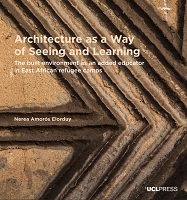Architecture as a Way of Seeing and Learning
The built environment as an added educator in East African refugee camps
| dc.contributor.author | Elorduy, Nerea Amorós | |
| dc.date.accessioned | 2021-12-08T12:16:02Z | |
| dc.date.available | 2021-12-08T12:16:02Z | |
| dc.date.issued | 2021 | |
| dc.identifier | ONIX_20211208_9781800080119_32 | |
| dc.identifier | OCN: 1264708014 | |
| dc.identifier.uri | https://library.oapen.org/handle/20.500.12657/51800 | |
| dc.description.abstract | At the beginning of 2020, 66 long-term refugee camps existed along the East African Rift. Millions of young children have been born at the camps and have grown up there, yet it is unknown how their surrounding built environments affect their learning and development. Architecture as a Way of Seeing and Learning presents an architect’s take on questions many academics and humanitarians ask. Is it relevant to look at camps through an urban lens and focus on their built environment? Which analytical benefits can architectural and design tools provide to refugee assistance and specifically to young children’s learning? And which advantages can assemblage thinking and situated knowledges bring about in analysing, understanding and transforming long-term refugee camps? Responding to the extreme lack of information about East African camps, Nerea Amorós Elorduy has built contextualised knowledge – nuanced, situated and participatory – to describe, study and transform the East African long-term camps, and uncover hidden agencies in refugee assistance. She uses architecture as a means to create new knowledge collectively, include more local voices and speculate on how to improve the educational landscape for young children. With this book, Amorós Elorduy brings nuance, contextualisation and empathy to the study and management of long-term refugee camps in East Africa. It is empathy, she argues, that will help change mindsets, decolonise humanitarian refugee assistance and its study. Crossing architecture, humanitarian aid and early career development, this book offers many practical learnings. | |
| dc.language | English | |
| dc.relation.ispartofseries | Design Research in Architecture | |
| dc.subject.classification | thema EDItEUR::A The Arts::AM Architecture::AMD Architecture: professional practice | en_US |
| dc.subject.classification | thema EDItEUR::J Society and Social Sciences::JB Society and culture: general::JBF Social and ethical issues::JBFD Housing and homelessness | en_US |
| dc.subject.classification | thema EDItEUR::J Society and Social Sciences::JB Society and culture: general::JBF Social and ethical issues::JBFG Refugees and political asylum | en_US |
| dc.subject.classification | thema EDItEUR::J Society and Social Sciences::JB Society and culture: general::JBF Social and ethical issues::JBFH Migration, immigration and emigration | en_US |
| dc.subject.classification | thema EDItEUR::5 Interest qualifiers::5P Relating to specific groups and cultures or social and cultural interests::5PB Relating to peoples: ethnic groups, indigenous peoples, cultures and other groupings of people::5PBC Relating to migrant groups / diaspora communities or peoples | en_US |
| dc.subject.classification | thema EDItEUR::J Society and Social Sciences::JB Society and culture: general::JBS Social groups, communities and identities::JBSD Urban communities | en_US |
| dc.subject.classification | thema EDItEUR::R Earth Sciences, Geography, Environment, Planning::RP Regional and area planning::RPC Urban and municipal planning and policy | en_US |
| dc.subject.other | architecture | |
| dc.subject.other | East Africa | |
| dc.subject.other | refugee camps | |
| dc.subject.other | schools | |
| dc.subject.other | learning environments | |
| dc.subject.other | urban planning | |
| dc.subject.other | urban studies | |
| dc.subject.other | built environment | |
| dc.subject.other | refugees | |
| dc.subject.other | migration | |
| dc.title | Architecture as a Way of Seeing and Learning | |
| dc.title.alternative | The built environment as an added educator in East African refugee camps | |
| dc.type | book | |
| oapen.identifier.doi | 10.14324/111.9781800080119 | |
| oapen.relation.isPublishedBy | df73bf94-b818-494c-a8dd-6775b0573bc2 | |
| oapen.relation.isbn | 9781800080119 | |
| oapen.relation.isbn | 9781800080126 | |
| oapen.imprint | UCL Press | |
| oapen.place.publication | London |

